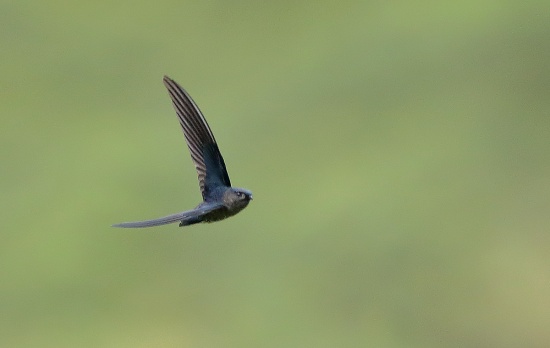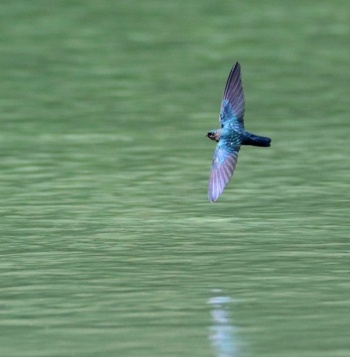- Collocalia esculenta
Identification
9.5 +/- centimeters/3 ½ inches, 5-10 grams/1/4 – ½ ounce +/-
- Small body
- Square tail
- Pronounced blue sheen to the upper body
- Throat brown
- Uneven, spotty shades of brown on the side of the body
- Varying degree of a white rump on races stresemanni, natalis, tame¬tamele, desiderata, uropygialis, marginataand septentrionalis
- Races manadensis and spilura can't be described as having a white shaded belly due to their pronounced darkness there.
Flight
When in flight, it can be distinguished from other Collocalia swiftlets (egs. Himalayan, Black-nest, Edible-nest, Germain's) by its distinctive whitish belly and all black upperparts without any pale rumpband.
Variations
Races stresemanni, natalis, tametamele, desiderata, uropygialis, marginata and septentrionalis differ in the amount of white on rump.
Races manadensis and spilura have very dark underparts.
Distribution
From the Northern Moluccas to Sulawesi, New Guinea, Bismarck Archipelago to Solomon Islands.
Taxonomy
Several species were formerly included in this species: Satin Swiftlet, Drab Swiftlet, Tenggara Swiftlet, Ridgetop Swiftlet, Grey-rumped Swiftlet, Plume-toed Swiftlet and Christmas Island Swiftlet.
Subspecies
Highly polytypic. Currently 17 subspecies are described[1]:
- C. e. spilura: Northern Moluccas
- C. e. manadensis: Northern Sulawesi, Sangihe, Siau, Talasea and Talaud islands
- C. e. esculenta: Central and southern Sulawesi, Banggai and Sula islands, South Moluccas (to Kai Islands), and Aru Islands
- C. e. minuta: Salayar, Bonerate, Tanahjampea and Kalao islands. (north Flores Sea)
- C. e. amethystina: Waigeo Island (off north-western New Guinea)
- C. e. numforensis: Numfor Island (off north-western New Guinea)
- C. e. nitens: New Guinea, western Papuan Islands, Yapen, and Karker
- C. e. misimae: Louisiade Archipelago (Misima and Rossel)
- C. e. stresemanni: Admiralty Islands (Manus, Rambutyo, Nauna, Los Negros)
- C. e. heinrothi: Bismarck Archipelago (New Hanover, Nusa, New Ireland, and Djaul)
- C. e. spilogaster: Bismarck Archipelago (Lihir Group and Tatau Islands)
- C. e. hypogrammica: Bismarck Archipelago (Nissan and Green)
- C. e. tametamele: Bismarck Archipelago (New Britain and Witu); Bougainville
- C. e. lagonoleucos: northwestern Solomon Islands (Buka and Bougainville; identify of population on Shortland not determined, but possibly this subspecies)
- C. e. becki: Central and north-eastern Solomon Islands; single record from Malaita
- C. e. makirensis: Makira (Solomon Islands)
- C. e. desiderata: Rennell (southern Solomon Islands)
Habitat
Recorded over different habitats, often in humid areas and often around human settlements. Forest, forest edge, cultivated land, villages, towns and from sea-level up to 4500m (in New Guinea).
Behaviour
Diet
This most conspicuous swiftlet, often feeding low over forest or close to the ground over streams and clearings, including roads. Takes various insects in flight, often foraging in large groups, also with other Swiftlets, Swifts or Swallows.
Breeding
Breeding season differs through range, but mostly between February and May. Nests singly or in colonies, building a small cup or half cup attached to a cliff, a wall, in a tree hollow, on rocks or even among roots of big trees. As the species is not capable of echolocation it does not breed in caves. Lays two eggs.
Movements
Resident.
References
- Clements, J. F., T. S. Schulenberg, M. J. Iliff, S. M. Billerman, T. A. Fredericks, J. A. Gerbracht, D. Lepage, B. L. Sullivan, and C. L. Wood. 2021. The eBird/Clements checklist of Birds of the World: v2021. Downloaded from https://www.birds.cornell.edu/clementschecklist/download/
- Chantler, P. and P. F. D. Boesman (2020). Glossy Swiftlet (Collocalia esculenta), version 1.0. In Birds of the World (S. M. Billerman, B. K. Keeney, P. G. Rodewald, and T. S. Schulenberg, Editors). Cornell Lab of Ornithology, Ithaca, NY, USA. https://doi.org/10.2173/bow.gloswi1.01
Recommended Citation
- BirdForum Opus contributors. (2024) Glossy Swiftlet. In: BirdForum, the forum for wild birds and birding. Retrieved 26 April 2024 from https://www.birdforum.net/opus/Glossy_Swiftlet
External Links
GSearch checked for 2020 platform.1





